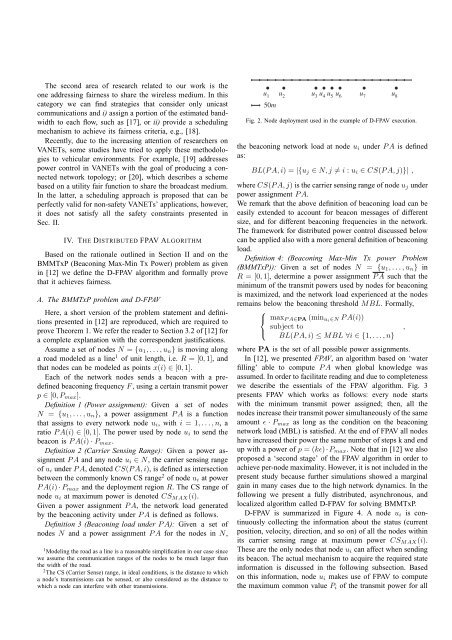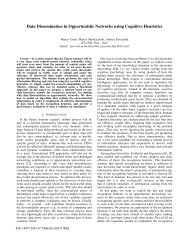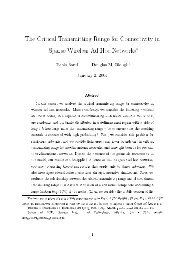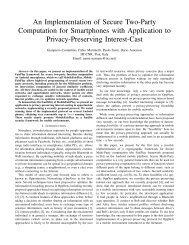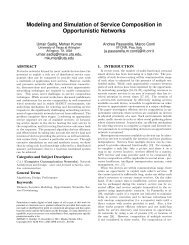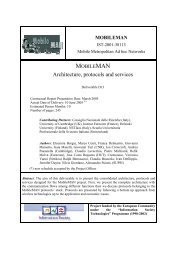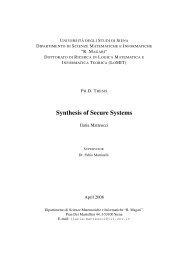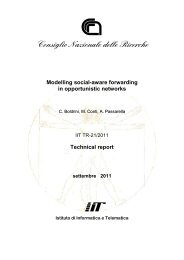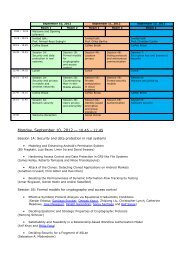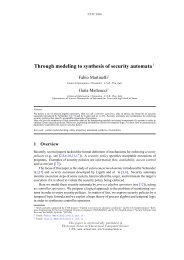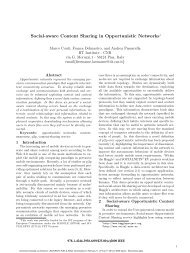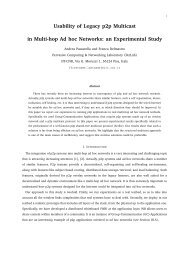Distributed Fair Transmit Power Adjustment for Vehicular Ad Hoc ...
Distributed Fair Transmit Power Adjustment for Vehicular Ad Hoc ...
Distributed Fair Transmit Power Adjustment for Vehicular Ad Hoc ...
Create successful ePaper yourself
Turn your PDF publications into a flip-book with our unique Google optimized e-Paper software.
The second area of research related to our work is theone addressing fairness to share the wireless medium. In thiscategory we can find strategies that consider only unicastcommunications and i) assign a portion of the estimated bandwidthto each flow, such as [17], or ii) provide a schedulingmechanism to achieve its fairness criteria, e.g., [18].Recently, due to the increasing attention of researchers onVANETs, some studies have tried to apply these methodologiesto vehicular environments. For example, [19] addressespower control in VANETs with the goal of producing a connectednetwork topology; or [20], which describes a schemebased on a utility fair function to share the broadcast medium.In the latter, a scheduling approach is proposed that can beperfectly valid <strong>for</strong> non-safety VANETs’ applications, however,it does not satisfy all the safety constraints presented inSec. II.IV. THE DISTRIBUTED FPAV ALGORITHMBased on the rationale outlined in Section II and on theBMMTxP (Beaconing Max-Min Tx <strong>Power</strong>) problem as givenin [12] we define the D-FPAV algorithm and <strong>for</strong>mally provethat it achieves fairness.A. The BMMTxP problem and D-FPAVHere, a short version of the problem statement and definitionspresented in [12] are reproduced, which are required toprove Theorem 1. We refer the reader to Section 3.2 of [12] <strong>for</strong>a complete explanation with the correspondent justifications.Assume a set of nodes N = {u 1 ,...,u n } is moving alonga road modeled as a line 1 of unit length, i.e. R = [0,1], andthat nodes can be modeled as points x(i) ∈ [0,1].Each of the network nodes sends a beacon with a predefinedbeaconing frequency F , using a certain transmit powerp ∈ [0,P max ].Definition 1 (<strong>Power</strong> assignment): Given a set of nodesN = {u 1 ,...,u n }, a power assignment PA is a functionthat assigns to every network node u i , with i = 1,...,n, aratio PA(i) ∈ [0,1]. The power used by node u i to send thebeacon is PA(i) · P max .Definition 2 (Carrier Sensing Range): Given a power assignmentPA and any node u i ∈ N, the carrier sensing rangeof u i under PA, denoted CS(PA,i), is defined as intersectionbetween the commonly known CS range 2 of node u i at powerPA(i) ·P max and the deployment region R. The CS range ofnode u i at maximum power is denoted CS MAX (i).Given a power assignment PA, the network load generatedby the beaconing activity under PA is defined as follows.Definition 3 (Beaconing load under PA): Given a set ofnodes N and a power assignment PA <strong>for</strong> the nodes in N,1 Modeling the road as a line is a reasonable simplification in our case sincewe assume the communication ranges of the nodes to be much larger thanthe width of the road.2 The CS (Carrier Sense) range, in ideal conditions, is the distance to whicha node’s transmissions can be sensed, or also considered as the distance towhich a node can interfere with other transmissions.u 1u 2u 3u 4u 5u 6u 7u 850mFig. 2. Node deployment used in the example of D-FPAV execution.the beaconing network load at node u i under PA is definedas:BL(PA,i) = |{u j ∈ N,j ≠ i : u i ∈ CS(PA,j)}| ,where CS(PA,j) is the carrier sensing range of node u j underpower assignment PA.We remark that the above definition of beaconing load can beeasily extended to account <strong>for</strong> beacon messages of differentsize, and <strong>for</strong> different beaconing frequencies in the network.The framework <strong>for</strong> distributed power control discussed belowcan be applied also with a more general definition of beaconingload.Definition 4: (Beaconing Max-Min Tx power Problem(BMMTxP)): Given a set of nodes N = {u 1 ,...,u n } inR = [0,1], determine a power assignment PA such that theminimum of the transmit powers used by nodes <strong>for</strong> beaconingis maximized, and the network load experienced at the nodesremains below the beaconing threshold MBL. Formally,⎧⎨⎩max PA∈PA (min ui∈N PA(i))subject toBL(PA,i) ≤ MBL ∀i ∈ {1,...,n}where PA is the set of all possible power assignments.In [12], we presented FPAV, an algorithm based on ‘waterfilling’ able to compute PA when global knowledge wasassumed. In order to facilitate reading and due to completenesswe describe the essentials of the FPAV algorithm. Fig. 3presents FPAV which works as follows: every node startswith the minimum transmit power assigned; then, all thenodes increase their transmit power simultaneously of the sameamount ǫ · P max as long as the condition on the beaconingnetwork load (MBL) is satisfied. At the end of FPAV all nodeshave increased their power the same number of steps k and endup with a power of p = (kǫ) ·P max . Note that in [12] we alsoproposed a ‘second stage’ of the FPAV algorithm in order toachieve per-node maximality. However, it is not included in thepresent study because further simulations showed a marginalgain in many cases due to the high network dynamics. In thefollowing we present a fully distributed, asynchronous, andlocalized algorithm called D-FPAV <strong>for</strong> solving BMMTxP.D-FPAV is summarized in Figure 4. A node u i is continuouslycollecting the in<strong>for</strong>mation about the status (currentposition, velocity, direction, and so on) of all the nodes withinits carrier sensing range at maximum power CS MAX (i).These are the only nodes that node u i can affect when sendingits beacon. The actual mechanism to acquire the required statein<strong>for</strong>mation is discussed in the following subsection. Basedon this in<strong>for</strong>mation, node u i makes use of FPAV to computethe maximum common value P i of the transmit power <strong>for</strong> all,


